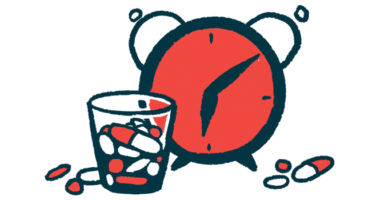FDA Asked to Consider Approving Berotralstat Capsules to Prevent HAE Attacks

BioCryst Pharmaceuticals has submitted a new drug application (NDA) to the U.S. Food and Drug Administration (FDA) requesting the approval of berotralstat (BCX7353), a once daily, oral treatment to prevent swelling attacks in people with hereditary angioedema (HAE).
The latest results of APeX-S and APeX-2 trials support the therapy’s safety and efficacy for about one year, showing that taking a 150 mg capsule of berotralstat once a day is able to lower mean attack rates from three to one or fewer per month.
“Thank you to all of the HAE patients who have participated in our clinical trials, to the clinical investigators and their teams around the world who conducted our clinical trials, and to the BioCryst team for always remembering that patients are waiting for our oral, once daily medicine,” Jon Stonehouse, CEO of BioCryst, said in a press release.
Berotralstat, also known as BCX7353, is a selective oral inhibitor of plasma kallikrein, a precursor of the inflammatory molecule bradykinin, the underlying cause of HAE. Patients produce too much bradykinin, causing blood vessels to dilate, and leading to angioedema attacks and pain.
The potential treatment is being developed in two formulations: an oral capsule to prevent angioedema attacks, and as an oral liquid for the treatment of acute HAE attacks.
BioCryst has two clinical trials underway evaluating berotralstat’s safety and its ability to prevent HAE attacks — a double-blind, placebo-controlled Phase 3 trial called APeX-2 (NCT03485911) and the open-label Phase 2/3 study APeX-S (NCT03472040), that will evaluate long-term safety and effectiveness.
APeX-2 enrolled 121 patients with type 1 or 2 HAE, and tested two oral doses of berotralstat. Initially, 41 patients received the lower 110 mg dose, 40 the higher 150 mg dose, and 40 others were on placebo, all given as once daily capsules for 24 weeks.
All 108 patients who completed treatment continued into its 48-week extension phase, where those previously on placebo were given one of therapy’s two doses.
Results from this part of the trial show that patients on berotralstat experienced a rapid and sustained decrease in their attack frequency over 48 weeks.
Seventy-five percent of patients taking the therapy’s 150 mg dose completed 48 weeks of treatment (about 12 months). At the beginning of the study, they had a mean of 2.9 attacks per month, which dropped to 1.4 after one month of treatment and then to one attack at 12 months of therapy.
Participants who switched from placebo to 150 mg of berotralstat at week 24 also experienced a “dramatic” and sustained reduction in angioedema attacks, BioCryst reported.
The frequency of their attacks declined to less than one per month, a mean of 0.4 monthly attacks, at the end of 12 months of therapy.
Berotralstat’s efficacy to control HAE flares was further confirmed in the study APeX-S, the open-label study evaluating the agent’s long-term safety and efficacy.
Most of the 73 patients who completed treatment with 150 mg berotralstat for 48 weeks remained attack-free for six of the study’s 12 months.
A joint analysis of APeX-2 and APeX-S data, with a total of 342 patients, showed no new safety findings and found berotralstat was generally well-tolerated.
The most common side effect was the common cold, occurring in the treated as often as in the placebo group. Gastrointestinal events led 3% of patients on berotralstat to leave the study. Serious adverse events related to treatment occurred in three subjects (0.9%) and resolved after stopping berotralstat.
In APeX-S, liver enzyme levels were elevated (specifically alanine aminotransferase, ALT) in 14 of 49 patients who stopped taking androgens within 28 days before this study’s start. This suggests that patients taking this type of therapy should do a four-week washout before starting on berotralstat.
Medicines based on synthetic androgens are used for the long-term prevention of HAE attacks and include Danocrine (danazol), Winstrol (stanozolol) and Oxandrin (oxandrolone).
“The 48-week clinical trial data we now have from APeX-S and APeX-2 highlight the control patients are having over their attacks with oral, once daily BCX7353, and consequently why 75 percent of patients stayed on-study through 48 weeks when they had other choices,” Stonehouse said in a press release of the trial updates.
According to a market research study by BioCryst, the prevalence of HAE in the U.S. is actually higher than previously thought. A claims data study estimates that about 10,000 residents have HAE, of which 7,500 are diagnosed and treated.
The study included a survey of 100 patients and 175 HAE-treating physicians. Doctors anticipate they will treat 80% of HAE patients with prophylactic (preventive) therapy in the future, and 41% expect to prescribe berotralstat to their patients.
“It is clear from this work that, regardless of their current treatment, HAE patients are eager to use, physicians are expecting to prescribe and payors are willing to reimburse oral once a day BCX7353,” Stonehouse added.






